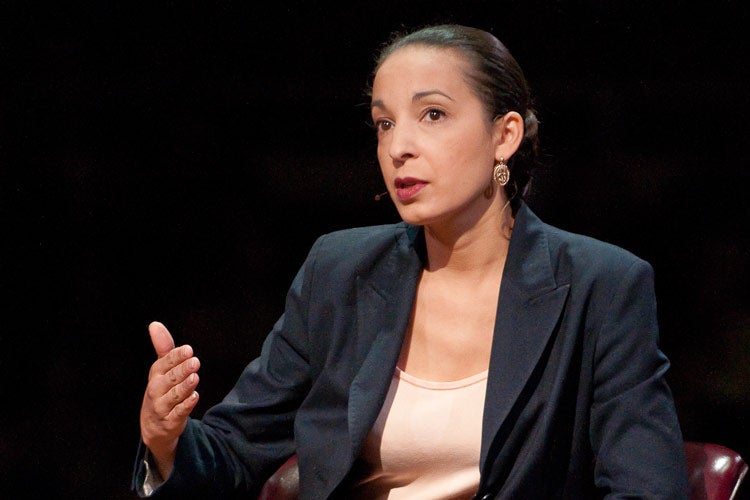
Stanford economist Caroline Hoxby is co-editor of How the Financial Crisis and Great Recession Affected Higher Education. (Image credit: L.A. Cicero)
When the Great Recession struck in 2008, it made young people think differently about American higher education, a Stanford economist says.
While job opportunities dipped during the recession, student interest in college increased, according to Caroline Hoxby, the Scott and Donya Bommer Professor of Economics at Stanford. She recently co-edited a book, How the Financial Crisis and Great Recession Affected Higher Education. She is also a senior fellow at the Hoover Institution and the Stanford Institute for Economic Policy Research.
The Stanford News Service interviewed Hoxby about this issue.
How did the Great Recession affect student access to higher education and their families who pay for it? Any good news?
The evidence shows that students were more likely to enroll in college and were more likely to stay in college during the Great Recession. This may seem surprising, but actually college-going has increased in every recession since the 1960s. What happens is that the opportunity cost of going to college – the job opportunities a person forgoes while in college – drops very dramatically during recessions. It is harder to find a job, to keep a job or to get a promotion. Thus, some people who would not enroll do enroll. People who would drop out stay enrolled. And people who would have taken some time off between undergraduate and graduate school decide to go straight to graduate school.
In short, even though families may find it more painful to pay for college during a recession because their incomes and home values are stagnant or falling, they do pay for college. This is the sense in which higher education is a counter-cyclical industry.
Just how painful was the cost of college attendance? The answer depends both on the family’s income and where the student enrolled. The federal Pell Grants program rose by 32 percent between 2006 and 2009. As a result, low-income students who qualify for the grant often paid less for college during the recession. However, some public and for-profit colleges raised tuition by about the same amount as the increase in the Pell Grant so that students were no better off. Private nonprofit colleges tended not to do this.
Public universities offer little explicit financial aid to middle- and upper-income families. Instead their tuition is kept artificially low by state appropriations. Economists call this implicit form of financial aid the “tuition subsidy.” During the recession, these tuition subsidies fell as states decided to spend their money elsewhere. As a result, middle- and upper-income students faced higher tuition at many state schools.
The schools were not spending any more money; they were just subsidizing tuition less. This was undoubtedly painful but, as already mentioned, students were still more likely to go to college. Even in California, where tuition subsidies fell a lot, provoking campus protests, the evidence suggests that only a tiny share of students even “downgraded” their enrollment by, for instance, choosing a cheaper CSU rather than a more expensive UC.
There is a good news side to all of this. Our population ends up more educated as the result of a recession. If you think that people ought to be getting more education anyway, this is an unexpected benefit. Also, since demand for higher education goes up, not down, during recessions, institutions are somewhat insulated from economic downturns. Because demand for education goes up, they can expand enrollment or raise tuition to make up for losses elsewhere.
In what ways did universities respond differently to the financial crisis?
Both public and private universities responded to the financial crisis and recession by cutting back on the hiring of young, tenure-line faculty. Staff payrolls, however, continued to grow. Also, despite claims to the contrary, there is no evidence that universities significantly reduced the number of faculty close to or over age 65.
The top public research universities drove new bargains with their state legislatures, obtaining more autonomy in return for accepting lower state funding. They used this autonomy to raise tuition and enroll more out-of-state students – who pay more than in-state students – in their most in-demand programs.
Top private research universities obtained research funding windfalls from the federal government’s generous stimulus budgets. This allowed them to reallocate some of the money they would otherwise have spent on research to other purposes such as financial aid.
What lessons or takeaways are there for universities from the financial crisis?
During the crisis, university leaders talked a lot about “creative destruction” – cutting ineffective programs, rationalizing the staff, rejuvenating the faculty by retiring expensive professors over age 65 and hiring inexpensive assistant professors. However, they did not actually do any amount of this creative destructive. It is hard to do such things at any time, but doing it during a crisis is easier than doing it when the economy is buoyant.
Media Contacts
Caroline Hoxby, Economics: (650) 725-8719, choxby@stanford.edu
Clifton B. Parker, Stanford News Service: (650) 725-0224, cbparker@stanford.edu